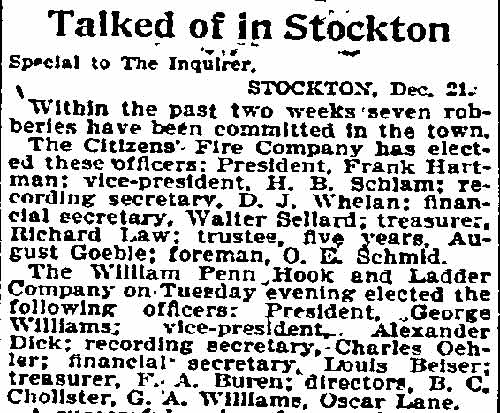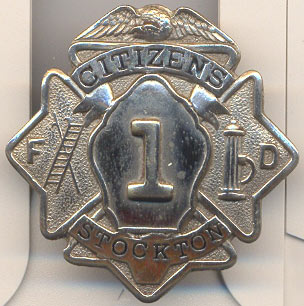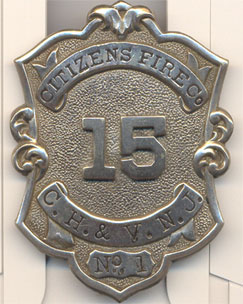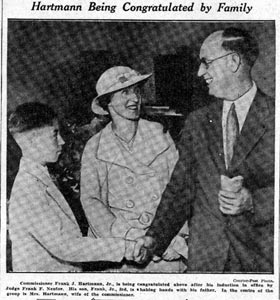|
Frank J. Hartmann Sr. |
|
||||
 |
Philadelphia
Inquirer December 21, 1895 William
Penn George Williams - Alexander Dick Click on Image for PDF File |
| Frank J. Hartmann Sr.'s Fire Department Badges | |
 |
 |
|
Frank Hartmann's hat badge from the Citizens Fire Company No. 1. Note that it indicates the Town of Stockton. |
Frank Hartmann's breast badge from the Citizens Fire Company No. 1. This badge was issued before Stockton was merged with Camden. Note the "C.H. (Cramer Hill) & V. N.J." |
 |
Philadelphia Inquirer Camden Lodge No. 293, |
| Camden Courier-Post * May 19, 1964 |
|
McGuire,
Hartmann Among The Early Organizers of Labor in City Camden
enjoys a special place in the nation's labor movement. Yet,
surprisingly, much of the history of the movement is unwritten and
rests in the minds and memories of its former leaders. Peter
J. McGuire is the man most remembered for his work in bringing the
labor movement to its current state of organization and as the founder
of Labor Day. But
there were others, such as Robert
Hartmann, Timothy Desmond, Walter
McDougall, William Harvey,
Thomas Gilligan, Joseph Graw, Rubin Price, Jim Reeves, Dick Mustard,
Andrew McGuire, Charles Hollopeter, William Dobbins, John Doran and
Spencer Huntley. Began
in 1890 The
move to bring the labor movement together began in about 1890
and
centered around the strong father and son relationship of Frank and
Robert Hartmann and the cigarmakers. Strangely enough, this union, which
is given credit by veteran labor leaders for cementing the workingman's
crusade into a unified force, no longer exists in Camden. The
first organized local was number 203, a splinter group from the old Knights of Labor
in Philadelphia. The cigarmakers were followed by the carpenters,
bricklayers, painters, hodcarriers, pottery workers, linemen and
typographers. The
Typographical Union, Local 132, is believed to be the oldest local
inexistence In Camden. The local's records show it was chartered in 1887
and
incorporated nine years later in 1896. One
of the very early organizers was
Robert Hartmann, who is now 89 years
old and lives at 1016 Collings Avenue, West Collingswood. The
movement had its birth in the Hartmann Cigar factory, 3rd
and Arch
Streets. The plant was the first built in the city with all union labor
and the first to be completely organized, a fact which industry and
management bitterly resented. Hostility
High
Hostility
toward those involved 65 years ago ran at a high pitch and owners of
halls and meeting places refused to rent their facilities for union
meetings. Consequently
meetings were held at the Hartmann factory and the owner- the late Frank
Hartmann, whose son was elected the first president of the cigarmakers
local- is looked on today as one of the benefactors of organized labor
in Camden. The
senior Hartmann, who lived in the 700 block
of State
Street and the
2800 block of Cleveland Avenue, was considered a dangerous liberal
because he believed in the idea of collective bargaining, an unheard-of
idea in his day. Place
to Meet The
Hartmann factory not only became the headquarters for the labor
movement, but it also provided a place where the controversial men, of
the day came to speak their piece on the workingman's problems. And
the problems were many. Wages were low-40 cents an hour for
carpenters-30 cents for common laborers - child labor and long hours. Labor
took its first real step in 1908 when the Camden County Central Labor
Union was created and Hartmann
was elected its first president. The
creation of the Central Labor Union brought together all the various
small locals which were being organized by
the
trades in the early years. According
to the charter, the Central Labor Union was formed "to better
conditions for the working man and to fight for human betterment." Worked
at 11 It
was during the formative days of the Central Labor Union that Peter J. McGuire's talents, came to the attention of unionists. McGuire
became a wage earner at 11 when he hawked newspapers on the streets of
New York, ran errands, shined shoes, and attended the Cooper Union
School for the underprivileged. It was here in about 1860 that he met
Samuel Gompers, co-founder of the American Federation of Labor. The
two were to go different ways, but reaching the same goals.
Unfortunately for the nation, McGuire saved nothing from the thousands
of letters, platforms and manifestos that he wrote during his career. Labor
Day Born At
age 20, McGuire was dedicated to revolution by labor as the first step
to its betterment, and was beating the drum for political action,
immediate and organized. Labor
Day was born, unofficially, on May 8, 1882, in New York City, when
McGuire proposed the idea at a meeting of the Central Labor Union in
Clarendon Hall on 13th Street. The
workingman "took" the first Labor Day on Tuesday, Sept. 6,
1882, and organized labor marched with bands and banners, up Broadway to
Union Square. The
first Labor Day celebration was to set the pattern for Labor Days to
follow. To
Camden in 1885
After
McGuire founded the Brotherhood of Carpenters and Joiners, he moved from
Chicago to Philadelphia where he eventually moved to Camden. The year
was 1885. At
the turn of the century, McGuire was earning $2,000 annually as
secretary of the Brotherhood. His hair had turned snow white. It
was during these first years that Camden got to know McGuire. The
association was short-lived for he died February 18, 1906, at the age of
54, a broken man and in want.
One
of his final acts was to pen a note to a friend. It said: "I'm very
tired of it all and of late, in looking my past in the face, I wonder if
the game was worth the poor candle, the more so when I see the
ingratitude of those who benefited by our labors." Today
organized labor tries to forgive itself for the "ingratitude"
by holding memorial services in Pennsauken's Arlington Cemetery in honor
of McGuire, the father of Labor Day. Faced
Same Problems Early
unionists in Camden faced the same problems that labor faced throughout the country at the turn
of the century. Among them were an eight hour day arid a workmen's
pension based on contributions from both employer and employee. These
problems were discussed at meetings held in the old Temple
Theater, 4th and Market Streets, now the site of the Camden Post
Office and in the Towers Theater,
at Broadway
and Pine
Street.
It
is recalled that Spencer Huntley organized the hodcarriers to fight for
a 10-cent an hour in crease after the price of pork chops went up three cents a pound. Camden
celebrated its first Labor Day in 1908 with a parade that had its start
on Cooper
Street.
About 200 unionists, dressed in their working clothes, marched down Cooper, Market, Broadway, and 5th Streets and then on to
Stockton Park {home
of the Stockton Rifles- PMC}
at 20th and Federal
Streets,
where they gathered for rousing speeches and a picnic. Wore Top Hat Leading
the paraders was Robert
Hartmann, dressed in a high top hat, and riding
a white horse borrowed from Schroeder's Funeral Home, located at that
time at 4th and Arch Streets. In
the early 1900s, organized labor was looked on as a militant group, led
by men with radical ideas, who were spreading revolution and who if
successful, would lead the nation to destruction. Labor met on Sunday
nights in the old Towers Theater, because it was the only day of the
week the workingman had to himself. It was the only way union leaders
could be sure of a full house. It
was on one of these occasions that Frank Morrison, then
secretary
of the budding AFL, addressed
Camden unionists and voiced labor's disapproval of America's
intervention in World War I. There
were other subjects discussed in the
Towers Theater, subjects closer to
home for the workingman .... education, public housing, slum clearance,
equal wages and fair employment opportunities ... subjects still being
talked about today. Promise
Kept It
was not until 1935, when Congress passed the Wagner Act, that organized
labor began to take on significance. Two years later another "big
jump" was taken. During
World War II, Camden enjoyed a period of labor peace. Labor had promised
the nation it would not strike during the war and in Camden that promise
was kept. And
organized labor got its feet wet in the political arena when it began to
lobby for compulsory education by packing the legislative gallery in
Trenton. Up
to now, labor had followed McGuire's theory ... "support
politically your friends, defeat your enemies, regardless of political
affiliations." Giants
Merge
On
April 28, 1961, the Central Labor Union and the Industrial Union
Council, a CIO organization, merged. New Jersey was to be the last state
in the union to complete the merger of the two giants, the AFL and the
CIO.
Locally.
85 unions with more than 75,000 members, overnight became members of one
organization. Today,
according to Central Labor Union president Joseph J. McComb, labor faces
as many problems as it did 50 years ago. The only difference is the type
of problem. Today
labor is faced with industrial automation, changing work assignments,
reduced work weeks and wages. But
today labor has also become big business. It operates rich health and
welfare funds; sponsors entire towns for its retired members; educates
its children and takes care of its social problems. Its officials are successful candidates for public office, sit on boards of community organizations, and run fund drives. It has become a potent force for the good of the entire community. |
 |
Camden
Courier-Post
August 2, 1935 Frank Hartman Jr., Click on Image to Enlarge
|